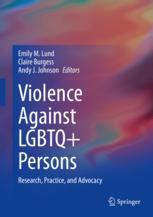This chapter introduces the topics of systemic and interpersonal violence against LGBTQ+ persons, a complex and multifaceted area that is marked by a variety of distinct but co- existing types of victimization. We describe this broad range of victimization, which spans from childhood to adulthood, covert to overt, and interpersonal to systematic, and discuss the cumulative effects of both acute and chronic victimization on the health and well- being of sexual and gender minority persons. We also highlight the importance of truly intersectional and culturally responsive care in working with LGBTQ+ clients who have experienced violence. Violence is a complex and multifaceted concept, and members of the LGBTQ+ community (i.e., individuals who are non-heterosexual, non- cisgender, and/or intersex) have long been sub- ject to increased rates of violence victimization in various forms (Katz-Wise & Hyde, 2012; Friedman et al., 2011). As detailed in the follow- ing chapters in this volume, violence against vari- ous communities under the LGBTQ+ umbrella is often both systematic—occurring at the level of social norms and political and public policy— and interpersonal, occurring at the level of the individual. This violence can be overt and explicit—up to and including homicide—and covert and subtle, such as microaggressions and invalidation (Nadal, Rivera, Corpus, & Sue, 2010). Although smaller-scale forms of aggres- sion are often considered to be of relatively little concern by outsiders, researchers have found that they often have a considerable and damaging cumulative impact on recipients and lead to fur- ther feelings of isolation and decreased well- being (Galupo & Resnick, 2016). Additionally, victimization of LGBTQ+ indi- viduals often occurs across the lifespan and in a variety of forms and circumstances (Katz-Wise & Hyde, 2012; Friedman et al., 2011). Although the “It Gets Better” campaign sparked a popular anti-suicide and anti-bullying meme campaign aimed at LGBTQ+ youth (Gal, Shifman,
چکیده فارسی
این فصل موضوعات خشونت سیستمیک و بین فردی علیه افراد دگرباش جنسی+ را معرفی میکند، حوزهای پیچیده و چندوجهی که با انواع مختلفی از قربانیزدایی متمایز اما مشترک مشخص شده است. ما این طیف وسیع از بزه دیدگی را که از کودکی تا بزرگسالی، پنهان تا آشکار، و بین فردی تا سیستماتیک را در بر می گیرد، توصیف می کنیم و اثرات تجمعی قربانی شدن حاد و مزمن بر سلامت و رفاه افراد اقلیت جنسی و جنسی را مورد بحث قرار می دهیم. ما همچنین اهمیت مراقبت واقعاً متقاطع و فرهنگی را در کار با مشتریان LGBTQ+ که خشونت را تجربه کردهاند، برجسته میکنیم. خشونت یک مفهوم پیچیده و چند وجهی است و اعضای جامعه LGBTQ+ (یعنی افرادی که غیر دگرجنسگرا، غیر همجنسگرا و/یا بینجنس هستند) مدتهاست که در معرض افزایش نرخ قربانیشدن خشونت به اشکال مختلف بودهاند (کاتز) -وایز و هاید، 2012؛ فریدمن و همکاران، 2011). همانطور که در فصلهای بعدی این جلد توضیح داده شد، خشونت علیه جوامع مختلف تحت چتر LGBTQ+ اغلب هم سیستماتیک است – که در سطح هنجارهای اجتماعی و سیاستهای سیاسی و عمومی اتفاق میافتد – و هم بینفردی است که در سطح فرد رخ میدهد. . این خشونت میتواند آشکار و صریح باشد - تا و از جمله قتل - و پنهان و ظریف، مانند تجاوزات خرد و بیاعتبار کردن (Nadal, Rivera, Corpus, & Sue, 2010). اگرچه شکلهای کوچکتر پرخاشگری اغلب بهعنوان نگرانی نسبتاً کمی توسط خارجیها در نظر گرفته میشوند، محققان دریافتهاند که اغلب تأثیر تجمعی قابلتوجهی و مخربی بر گیرندگان دارند و منجر به احساس انزوای بیشتر و کاهش رفاه میشوند. (Galupo & Resnick، 2016). علاوه بر این، قربانی شدن افراد LGBTQ+ اغلب در طول عمر و در اشکال و شرایط مختلف رخ می دهد (کاتز-وایز و هاید، 2012؛ فریدمن و همکاران، 2011). اگرچه کمپین "بهتر می شود" یک کمپین محبوب ضد خودکشی و ضد قلدری با هدف جوانان LGBTQ+ (Gal, Shifman,
) ایجاد کرد.
ادامه ...
بستن ...
This chapter introduces the topics of systemic and interpersonal violence against LGBTQ+ persons, a complex and multifaceted area that is marked by a variety of distinct but co- existing types of victimization. We describe this broad range of victimization, which spans from childhood to adulthood, covert to overt, and interpersonal to systematic, and discuss the cumulative effects of both acute and chronic victimization on the health and well- being of sexual and gender minority persons. We also highlight the importance of truly intersectional and culturally responsive care in working with LGBTQ+ clients who have experienced violence. Violence is a complex and multifaceted concept, and members of the LGBTQ+ community (i.e., individuals who are non-heterosexual, non- cisgender, and/or intersex) have long been sub- ject to increased rates of violence victimization in various forms (Katz-Wise & Hyde, 2012; Friedman et al., 2011). As detailed in the follow- ing chapters in this volume, violence against vari- ous communities under the LGBTQ+ umbrella is often both systematic—occurring at the level of social norms and political and public policy— and interpersonal, occurring at the level of the individual. This violence can be overt and explicit—up to and including homicide—and covert and subtle, such as microaggressions and invalidation (Nadal, Rivera, Corpus, & Sue, 2010). Although smaller-scale forms of aggres- sion are often considered to be of relatively little concern by outsiders, researchers have found that they often have a considerable and damaging cumulative impact on recipients and lead to fur- ther feelings of isolation and decreased well- being (Galupo & Resnick, 2016). Additionally, victimization of LGBTQ+ indi- viduals often occurs across the lifespan and in a variety of forms and circumstances (Katz-Wise & Hyde, 2012; Friedman et al., 2011). Although the “It Gets Better” campaign sparked a popular anti-suicide and anti-bullying meme campaign aimed at LGBTQ+ youth (Gal, Shifman,
ادامه ...
بستن ...










